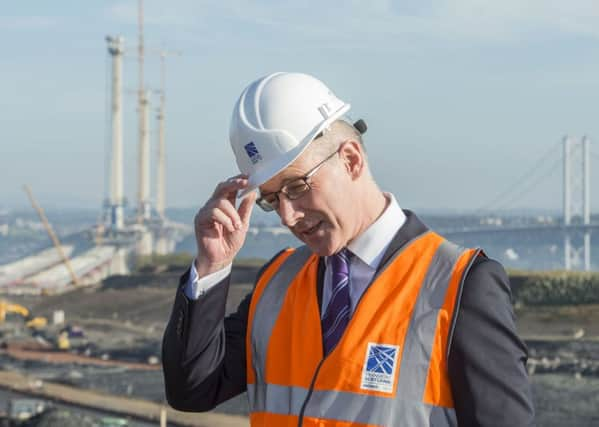Bill Jamieson: The election question that really matters


The more robust the economy, the stronger the tax revenues flowing into Scottish Government coffers.
Party politics at Holyrood would have to take a broader view, taking into account the overall state of the economy and its ability to generate tax revenues rather than an obsessive focus on public spending and competing spending manifestos.
Advertisement
Hide AdAdvertisement
Hide AdThese new powers to vary the rate of income tax in Scotland have now arrived. The Scottish Rate of Income Tax (SRIT) took effect from 5 April, with further tax varying powers set to kick in during the next Scottish Parliament.
But with the election now less than a month away, how much notice has been taken of Scotland’s current economic performance in the campaign thus far?
All too little. Holyrood politics proceeds on a series of claims and counter-claims about invalidity benefits, carers’ allowances and which party would do most to reverse public spending cuts.
Scotland’s 2016 parliamentary election is thus in danger of missing the big picture: the current performance of the economy and its ability to deliver higher revenues.
Not only is Scotland’s economy barely growing and continuing to lag that of the UK overall, but there is a real danger that it could lapse into recession – if it has not already done so.
The conventional measure of recession is two consecutive quarters of falling growth. So how close are we to this?
Scotland’s economy grew by 0.2 per cent in the final quarter of 2015, but continued to trail the performance of the UK as a whole – growth here was up by 0.6 per cent. On an annual basis, Scotland’s GDP grew by 0.9 per cent, while UK GDP grew by 2.1 per cent.
And the previous quarter’s estimate for growth here was revised down by Scotland’s chief statistician from plus 0.1 per cent to minus 0.1 per cent – ending a run of 11 straight quarters of growth.
Advertisement
Hide AdAdvertisement
Hide AdWe need to watch these revisions. As Douglas Fraser, BBC Scotland’s inestimable economy-watcher, points out, “if the same happens to the most recent figures for the last quarter of 2015, two quarters of contraction would mean Scotland has been in recession”. And we will not know about this until the next figures are released in July – well after the Holyrood election battle.
Now, it is true that if you look at GDP per head the picture looks a little better. Last year’s growth in economic output per head in Scotland is fractionally higher than the UK as a whole – 1.6 per cent against 1.5 per cent. The Scottish Government understandably prefers to cite these figures.
But while they could be said to provide a better guide to how prosperous we are, it would be unwise to base our economic assessment on the basis of relative movements of population growth and statistical variations of head count north and south of the Border.
And I doubt if we feel that much better on being told our GDP per capita is fractionally higher than that of residents of Carlisle. In fact, output per head is still below the pre-recession peak in the second quarter of 2008, so even on this measure we are doing no better than eight years ago.
And we should not lose sight of the bigger picture – that the economy has lost its growth impetus, with sectors struggling to keep their head above water.
Construction sector growth almost ground to a halt but still shows a remarkable performance for the year as a whole, up almost 20 per cent – due largely to a massive increase in spend on new infrastructure projects in 2015. But economist John McLaren continues to have doubts over these figures. Scottish employment levels in this industry, he adds, have been virtually flat over the two years.
While the fall in oil and gas output has dominated the headlines, there have been bigger falls down the offshore supply chain, with metals and metal products down by more than 18 per cent and the computers and electricals sector down by 8.4 per cent.
Performance of the dominant services sector has been notably patchy and lacklustre, with growth of just 0.9 per cent over the past 12 months compared with 2.7 per cent growth across the UK overall.
Advertisement
Hide AdAdvertisement
Hide AdWhat of the future? According to the latest quarterly report from the Federation of Small Businesses (FSB), a majority of smaller firms in Scotland expect business conditions to get worse. And the latest Small Business Index finds UK small business confidence at its lowest level since 2013.
Data elsewhere also points to a sharp fall in business conditions in Scotland’s private sector, with output declines and incoming new business falling. Further details should be released tomorrow.
And the picture for the UK as a whole gives little comfort. Industrial production unexpectedly fell 0.3 per cent month-on-month in February as a sharp dip in manufacturing output outweighed a rebound in oil and gas extraction and higher energy output. Meanwhile, the overall trade deficit has remained worryingly large at £4.8 billion in February.
Scotland’s politicians should be paying much more attention to our economic performance and the latest pointers than they have done so far. How will their policies boost growth? That is the question that really matters.